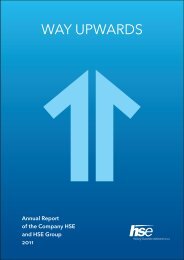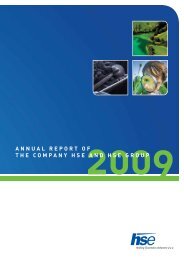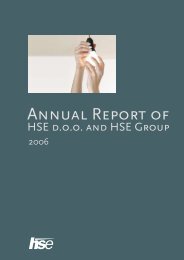ANNUAL REPORT - HSE
ANNUAL REPORT - HSE
ANNUAL REPORT - HSE
You also want an ePaper? Increase the reach of your titles
YUMPU automatically turns print PDFs into web optimized ePapers that Google loves.
<strong>ANNUAL</strong> <strong>REPORT</strong> <strong>HSE</strong> | FINANCIAL <strong>REPORT</strong> OF THE <strong>HSE</strong> GROUP<br />
Net profit or loss represents the unallocated portion<br />
of net profit or loss of the controlling company for the<br />
year and the controlling company’s share of subsidiaries’<br />
net profit or loss.<br />
Revaluation surplus includes the values of hedging<br />
derivatives (futures and interest rate swaps) and the<br />
value of increases in investments in associates accounted<br />
for using the equity method.<br />
Consolidation equity adjustment comprises foreign<br />
exchange differences arising from conversions of accounting<br />
categories used by companies abroad.<br />
Minority interest represents the share of minority<br />
owners in the total equity of subsidiaries.<br />
Provisions and long-term accrued<br />
costs and deferred revenue<br />
Provisions are set aside for obligations that are expected<br />
to arise from obligating past events in a period<br />
of more than a year. If a liability can be reliably measured,<br />
they are carried as recognised costs of provisions.<br />
The amounts of provisions for jubilee benefits and<br />
termination benefits were estimated on the basis of<br />
actuarial calculations. They were created based on an<br />
estimated amount of liabilities for termination and jubilee<br />
benefits discounted to the balance sheet date.<br />
Provisions are derecognised in the books of account<br />
when the events for which they were created occur or<br />
when it is determined that the reasons for their creation<br />
no longer exist. In this case their derecognition<br />
is recorded as operating revenue.<br />
Long-term deferred cost and accrued revenue items<br />
comprise deferred revenue that is expected to arise<br />
in a period of more than a year. They also include the<br />
values of grants for the acquisition of property, plant<br />
and equipment provided to cover depreciation charge<br />
through progressive transfers to operating revenue.<br />
Long-term liabilities<br />
Long-term liabilities arise in connection with the financing<br />
of group companies and can either be financial<br />
or operating.<br />
They refer to the liabilities of group companies which<br />
need to be settled over the period of more than a<br />
year.<br />
Long-term financial liabilities relate to liabilities to lenders<br />
whereas operating liabilities relate to suppliers.<br />
On initial recognition, long-term financial liabilities<br />
are recorded in the amount of cash received and are<br />
subsequently decreased by the amount of repayments<br />
made. They are measured at cost.<br />
Short-term operating liabilities are initially valued on<br />
the basis of amounts indicated in relevant documents,<br />
which evidence the receipt of goods or services.<br />
The portion of long-term liabilities that is due to be<br />
settled within a year of the balance sheet date is recorded<br />
as a short-term liability.<br />
The carrying amount of long-term liabilities equals<br />
their amortised cost.<br />
Short-term liabilities<br />
Short-term liabilities need to be settled within one<br />
year at the latest. The Group records short-term financial<br />
and operating liabilities.<br />
Short-term financial liabilities relate to liabilities to<br />
lenders whereas operating liabilities relate to suppliers.<br />
On initial recognition, short-term financial liabilities<br />
are recorded in the amounts of cash received and are<br />
subsequently decreased on the basis of repayments<br />
made. They are measured at cost.<br />
Long-term operating liabilities are initially valued on<br />
the basis of amounts indicated in relevant documents,<br />
which evidence the receipt of goods or services.<br />
The portion of long-term liabilities that is due to be<br />
settled within a year of the balance sheet date is recorded<br />
as a short-term liability.<br />
The carrying amount of short-term liabilities equals<br />
their amortised cost.<br />
142
















